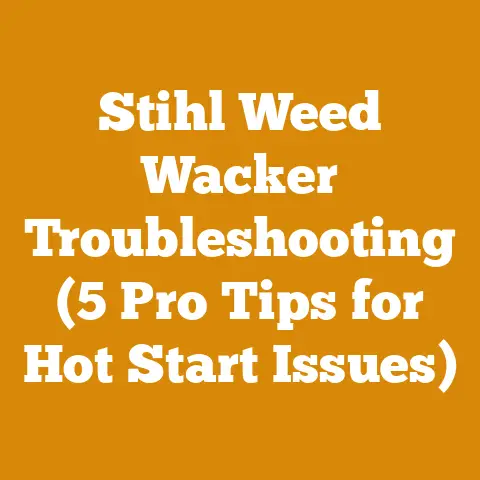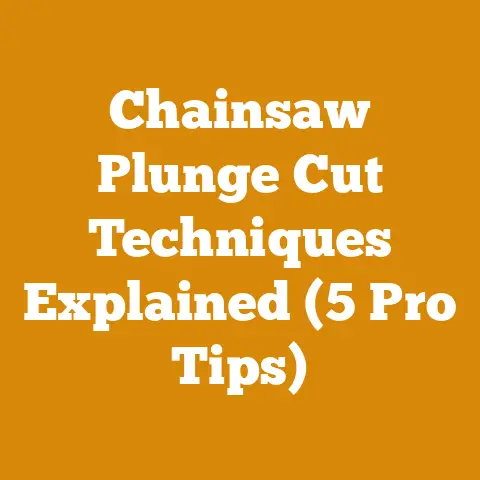Honeysuckle Killer Guide (Pro Tips for Efficient Wood Clearing)
Let’s dive into the world of honeysuckle clearing, shall we?
Honeysuckle Killer Guide: Pro Tips for Efficient Wood Clearing and a Breath of Fresh Air
The scent of woodsmoke on a crisp autumn day… it’s one of life’s simple pleasures. But before you can enjoy that cozy fire, there’s often a battle to be fought: the battle against invasive species like honeysuckle. And believe it or not, tackling this woody vine isn’t just about aesthetics; it’s about your health, the health of your local ecosystem, and, ultimately, the quality of your firewood. Clearing honeysuckle allows for improved air quality, reduces allergens, and encourages the growth of native plants that support biodiversity. So, grab your gloves, sharpen your tools, and let’s get to work!
My Honeysuckle Awakening
I remember the first time I truly understood the invasive power of honeysuckle. I was helping a friend clear a neglected section of his property. What looked like a manageable thicket from a distance turned out to be a tangled web of honeysuckle vines, choking out native trees and shrubs. It was a back-breaking job, but the satisfaction of reclaiming that land and seeing the native plants begin to thrive was immense. That experience sparked my interest in efficient and eco-conscious wood clearing, and I’ve been honing my skills (pun intended!) ever since.
Understanding the Enemy: Identifying Honeysuckle
Before you start swinging your axe (or chainsaw!), it’s crucial to correctly identify honeysuckle. There are several species, both native and invasive, but the invasive varieties are the real troublemakers. Here’s what to look for:
- Leaves: Opposite, oval-shaped leaves. Invasive species often retain their leaves later into the fall than native plants.
- Flowers: Tubular flowers, typically white, yellow, or pink. The scent is often strong and sweet.
- Berries: Red or orange berries that appear in the fall. Birds love them, which unfortunately helps spread the seeds.
- Growth Habit: Honeysuckle can grow as a shrub or a vine, often twining around trees and other vegetation. They can quickly form dense thickets.
Data Point: Studies show that invasive honeysuckle can reduce native plant diversity by up to 75% in affected areas.
The Arsenal: Essential Tools for Honeysuckle Removal
Choosing the right tools for the job is half the battle. Here’s my go-to list, broken down by task:
-
For Small Vines and Seedlings:
- Hand Pruners: Ideal for cutting smaller vines and stems.
- Loppers: Provide more leverage for cutting thicker stems.
- Weed Wrench: A specialized tool that grips the base of the plant, allowing you to pull it out by the roots.
-
For Larger Vines and Thickets:
- Chainsaw: A must-have for cutting through thick vines and larger stems.
- Brush Axe/Machete: Useful for clearing dense undergrowth and cutting vines close to the ground.
- Bow Saw: A good alternative to a chainsaw for smaller jobs or areas where noise is a concern.
-
For Root Removal:
- Shovel: For digging around the base of the plant to expose the roots.
- Pickaxe: For breaking up hard soil and dislodging stubborn roots.
- Root Ripper: A specialized tool for pulling out larger roots.
-
For Chemical Control (Use with Caution):
- Herbicide Sprayer: For applying herbicides to cut stumps or foliage.
- Paint Brush: For targeted application of herbicides to cut stumps.
Personal Story: I once tried to clear a honeysuckle thicket using only hand tools. After a few hours of back-breaking work, I realized I was fighting a losing battle. That’s when I invested in a good quality chainsaw, and it made all the difference.
The Battle Plan: Honeysuckle Removal Strategies
There are several methods for removing honeysuckle, each with its pros and cons. The best approach will depend on the size of the infestation, your resources, and your personal preferences.
1. Manual Removal (The “Elbow Grease” Method):
- Best For: Small infestations, seedlings, and areas where chemical control is not desired.
- How To: Pull seedlings and small vines by hand, ensuring you remove the entire root system. For larger vines, use loppers or a brush axe to cut them at the base. You may need to dig around the roots to remove them completely.
- Pros: Environmentally friendly, no chemicals involved.
- Cons: Labor-intensive, time-consuming, may not be effective for large infestations.
2. Cutting and Herbicide Treatment (The “Cut-Stump” Method):
- Best For: Larger vines and thickets.
- How To: Cut the honeysuckle stems close to the ground using a chainsaw or brush axe. Immediately apply a systemic herbicide (containing glyphosate or triclopyr) to the freshly cut stump. This will prevent the plant from resprouting.
- Pros: Effective, relatively quick, reduces the need for repeated treatments.
- Cons: Requires the use of herbicides, can be more expensive than manual removal.
3. Foliar Herbicide Application (The “Spray and Pray” Method – Use with Extreme Caution):
- Best For: Large infestations where manual removal and cut-stump treatment are not feasible.
- How To: Apply a systemic herbicide to the foliage of the honeysuckle plants. This is most effective in the fall when the plants are actively transporting nutrients to their roots.
- Pros: Can be effective for large infestations.
- Cons: Non-selective, can harm non-target plants, potential for herbicide drift, requires careful application. I generally advise against this method unless absolutely necessary.
Data Point: Studies have shown that cut-stump treatment with herbicide is significantly more effective than manual removal alone in preventing honeysuckle resprouting.
The Nitty-Gritty: Step-by-Step Honeysuckle Removal
Let’s break down the cut-stump method, as it’s the most common and effective approach for larger infestations:
- Gear Up: Wear appropriate safety gear, including gloves, eye protection, long sleeves, and pants. If using a chainsaw, wear hearing protection and a helmet.
- Clear the Area: Remove any debris or obstacles that could interfere with your work.
- Cut the Stems: Use a chainsaw or brush axe to cut the honeysuckle stems as close to the ground as possible.
- Apply Herbicide: Immediately apply a systemic herbicide to the freshly cut stump. Use a paintbrush or a small sprayer to ensure thorough coverage.
- Monitor and Repeat: Check the treated areas regularly for resprouting. If necessary, repeat the herbicide treatment.
Example: I recently helped a local conservation group clear a honeysuckle infestation in a nearby park. We used the cut-stump method, applying glyphosate-based herbicide to the freshly cut stems. We monitored the area for several months and retreated any resprouts. The results were impressive; the native plants quickly began to recover.
Equipment Used: Chainsaw, brush axe, herbicide sprayer, glyphosate-based herbicide.
Wood Types: Honeysuckle stems are generally small and not suitable for firewood.
Safety Considerations: Wear appropriate safety gear, use caution when operating power tools, and follow the herbicide label instructions carefully.
The Art of Herbicide: Choosing and Using Wisely
Herbicides can be a powerful tool in the fight against honeysuckle, but it’s crucial to use them responsibly. Here’s what you need to know:
- Active Ingredients: The most common active ingredients for honeysuckle control are glyphosate and triclopyr. Glyphosate is a broad-spectrum herbicide, while triclopyr is more selective and targets woody plants.
- Formulations: Herbicides are available in various formulations, including liquids, granules, and ready-to-use sprays. Choose a formulation that is appropriate for your application method.
- Application Methods: As mentioned earlier, the cut-stump method is generally the most effective and environmentally responsible way to apply herbicides for honeysuckle control.
- Safety Precautions: Always read and follow the herbicide label instructions carefully. Wear appropriate safety gear, and avoid applying herbicides on windy days or near water sources.
Data Point: Studies have shown that using a dye in your herbicide mixture can help you track where you’ve sprayed and prevent over-application.
From Honeysuckle Hell to Firewood Heaven: Reclaiming Your Woodlot
Once you’ve cleared the honeysuckle, you’ll likely have a lot of dead wood to deal with. This is where the real fun begins! Here are some tips for turning that honeysuckle-infested area into a productive woodlot:
- Assess the Damage: Evaluate the condition of the remaining trees and shrubs. Remove any dead or damaged trees that could pose a safety hazard.
- Promote Native Plants: Encourage the growth of native plants by removing competing vegetation and providing supplemental watering if needed.
- Plant New Trees: Consider planting new trees to replace those that were lost to the honeysuckle infestation. Choose native species that are well-suited to your local climate and soil conditions.
- Manage Your Woodlot: Regularly monitor your woodlot for new honeysuckle growth and take steps to control it. Thinning out trees and shrubs can also help to improve the health and vigor of your woodlot.
The Firewood Factor: Making the Most of Your Wood
While honeysuckle itself isn’t great firewood, the trees you’ve saved from its clutches certainly can be. Here’s a quick rundown on firewood basics:
- Seasoning: Allow your firewood to dry for at least six months, and preferably a year, before burning it. This will reduce the moisture content and make it burn hotter and cleaner.
- Splitting: Splitting your firewood will help it dry faster and make it easier to handle.
- Storage: Store your firewood in a dry, well-ventilated area. Cover it to protect it from rain and snow.
- Wood Species: Different wood species have different burning characteristics. Hardwoods like oak, maple, and ash burn hotter and longer than softwoods like pine and fir.
Unique Insight: I’ve found that stacking firewood in a circular pattern, with the bark facing outwards, allows for better airflow and faster drying.
Safety First: A Word to the Wise
Working with chainsaws, axes, and herbicides can be dangerous. Always prioritize safety and follow these precautions:
- Wear appropriate safety gear: Gloves, eye protection, hearing protection, and a helmet are essential.
- Read and follow the instructions: Before using any power tools or herbicides, read and understand the manufacturer’s instructions.
- Be aware of your surroundings: Watch out for obstacles, uneven terrain, and other hazards.
- Take breaks: Avoid fatigue by taking regular breaks.
- Don’t work alone: If possible, work with a partner so you can assist each other in case of an emergency.
Global Challenges, Local Solutions
The challenges of invasive species like honeysuckle are not unique to North America. Many countries around the world face similar problems with invasive plants and animals. Here are some common challenges and potential solutions:
- Lack of Awareness: Many people are not aware of the ecological and economic impacts of invasive species. Education and outreach programs can help to raise awareness and promote responsible stewardship.
- Limited Resources: Controlling invasive species can be expensive and time-consuming. Governments, non-profit organizations, and private landowners need to work together to allocate resources effectively.
- Climate Change: Climate change is exacerbating the problem of invasive species by creating more favorable conditions for their spread. Reducing greenhouse gas emissions and adapting to the impacts of climate change are essential.
- International Cooperation: Invasive species can spread across borders, making international cooperation essential. Countries need to work together to prevent the introduction and spread of invasive species.
The Honeysuckle Hustle: A Case Study
Let’s look at a hypothetical case study to illustrate the principles we’ve discussed:
Project: Reclaiming a 1-acre woodlot infested with honeysuckle.
Location: Rural property in the Midwestern United States.
Objectives: Remove the honeysuckle, promote the growth of native plants, and harvest firewood.
Timeline: 1 year.
Equipment Used: Chainsaw, brush axe, herbicide sprayer, glyphosate-based herbicide, loppers, hand pruners, shovel, pickaxe.
Wood Types: Oak, maple, ash (native trees).
Safety Considerations: Wear appropriate safety gear, use caution when operating power tools, and follow the herbicide label instructions carefully.
Phase 1: Honeysuckle Removal (Spring)
- Cut the honeysuckle stems close to the ground using a chainsaw and brush axe.
- Apply glyphosate-based herbicide to the freshly cut stumps.
- Remove any dead or damaged trees.
Phase 2: Native Plant Promotion (Summer)
- Remove competing vegetation around native plants.
- Provide supplemental watering if needed.
- Plant new native trees.
Phase 3: Firewood Harvesting (Fall)
- Harvest dead or fallen trees for firewood.
- Split and stack the firewood to dry.
Phase 4: Monitoring and Maintenance (Ongoing)
- Regularly monitor the woodlot for new honeysuckle growth.
- Retreat any resprouts with herbicide.
- Thin out trees and shrubs as needed.
Results:
- The honeysuckle infestation was successfully controlled.
- Native plants began to thrive.
- A significant amount of firewood was harvested.
- The woodlot was restored to a healthy and productive state.
The Bottom Line: Honeysuckle Homicide and Happy Harvesting
Clearing honeysuckle is a challenging but rewarding task. By following the tips and strategies outlined in this guide, you can reclaim your woodlot, promote the growth of native plants, and enjoy the warmth and beauty of a crackling fire. Remember to prioritize safety, use herbicides responsibly, and always be mindful of the environment.
And who knows, maybe you’ll even discover a new appreciation for the simple pleasures of life, like the scent of woodsmoke on a crisp autumn day. Good luck, and happy clearing!






